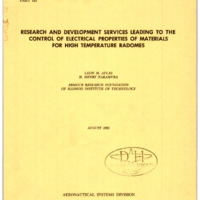-
Title
-
Research And Development Services Leading To The Control Of Electrical Properties Of Materials For High Temperature Radomes
-
Date
-
1961
-
Index Abstract
-
Not Available
-
Photo Quality
-
Not Needed
-
Report Number
-
WADC TR 59-300 Part 3
-
Creator
-
Atlas, Leon M.
-
Nakamura, H. Henry
-
Corporate Author
-
Armour Research Foundation of Illinois Institute of Technology
-
Laboratory
-
Directorate of Materials and Processes
-
Extent
-
20
-
Identifier
-
AD0268035
-
Access Rights
-
OTS
-
Distribution Classification
-
1
-
Contract
-
AF 33(616)-5929
-
DoD Project
-
7371
-
DoD Task
-
73710
-
DTIC Record Exists
-
Yes
-
Report Availability
-
Full text available
-
Date Issued
-
1961-08
-
Abstract
-
High purity and doped alumina ceramics previously prepared on this program by cold pressing and sintering rarely exceeded 90% of theoretical
density. Therefore hot pressing in argon was applied to pure aluminas prepared at ARF and to a commercial high purity product (Gulton Alucer MC). Densities in the range 3.85 g/cm<sup>3</sup> (for ARF alumina) to 3.97 g/cm<sup>3</sup> (for the Alucer MC) were readily obtained at 1650°-1750°C and 3000-3500 psi. Although the specimens were apparently rendered completely free of carbon by annealing in oxygen at 1500 to 1700 °C, their dissipation factors were much higher than for sintered discs made from the same powders. These anomalously high losses appear to be caused by the absorption of impurity cations from the graphite hot pressing dies despite their low ash content. With the objective of compensating the positive temperature variation of dielectric constant (k') characteristic of alumina regardless of its purity, compositions were formulated containing a titanate phase whose temperature variation of k' is negative. Attention was concentrated on SrTiO<sub>3</sub> and SrTiO<sub>3</sub>-BaTiO<sub>3</sub> solid solutions of C. P. grade in the concentration range 8 to 20% by weight. At a level of 14% SrTiO<sub>3</sub>, the k' of a titanate-alumina ceramic varied only 2.8% between 25 and 500°C at 10<sup>6</sup> c/s and 1.0% a t 4 x 10<sup>9</sup> c/s as compared to 5. 5 to 6.8%
for high purity aluminas. The stable coexistence of Al<sub>2</sub>O<sub>3</sub> and SrTiO<sub>3</sub> on firing suggests a eutectic
system which is actually pseudo binary because of the dissociation of the titanate. This eutectic was approximately located in the composition interval 65-70 % SrTiO<sub>3,</sub> and near 1625 °C. Ceramics having the composition 12% SrTiO<sub>3</sub>-88% Al<sub>2</sub>O<sub>3</sub> were
evaluated under four point flexural loading at room temperature, 500 °C, and 1000 °C. Although the test specimens had 10% total porosity, application
of Knudsen's equation demonstrated that the potential strength of the composite material was about the same as that of a commercial high
alumina ceramic of the same porosity and grain size. The strength decrement with rising temperature (up to 1000 °C) was also similar for both materials.
-
Provenance
-
Bombardier/Aero
-
Type
-
report
-
Format
-
20 pages ; 28 cm.
-
Date Modified
-
Scanned and posted 2023-09-27
 WADCTR59-300part03.pdf
WADCTR59-300part03.pdf